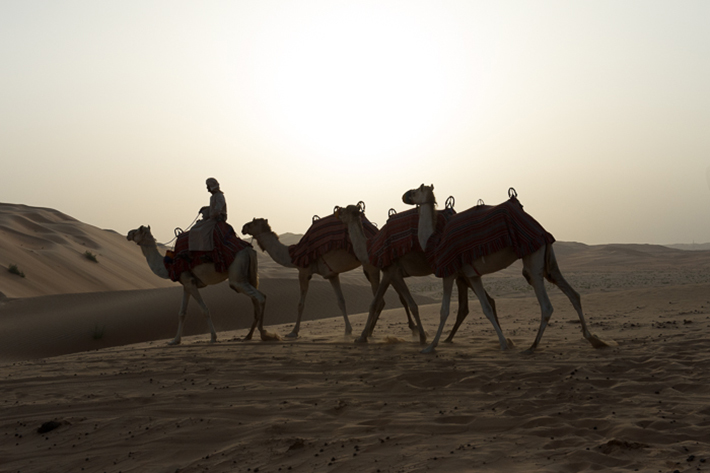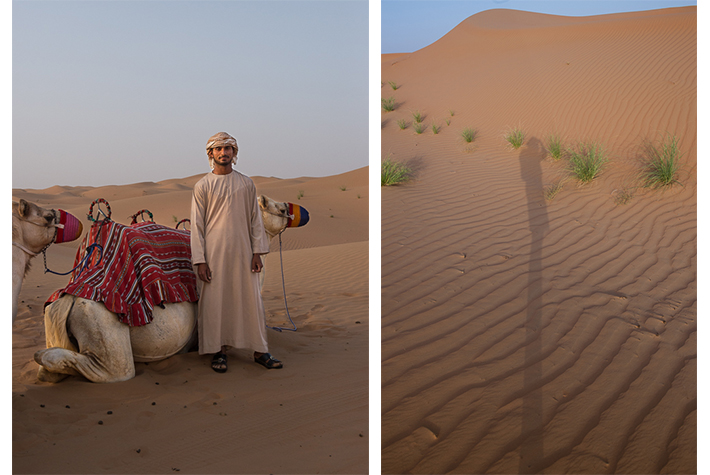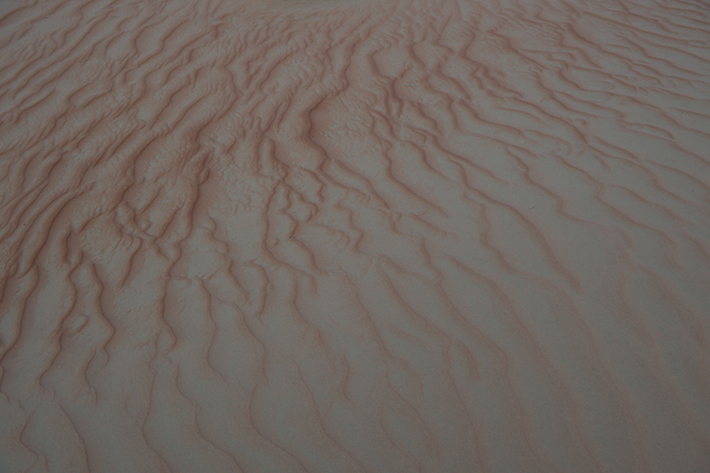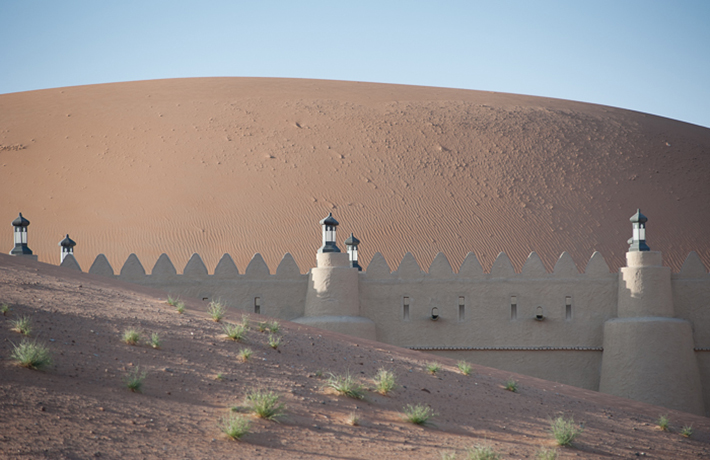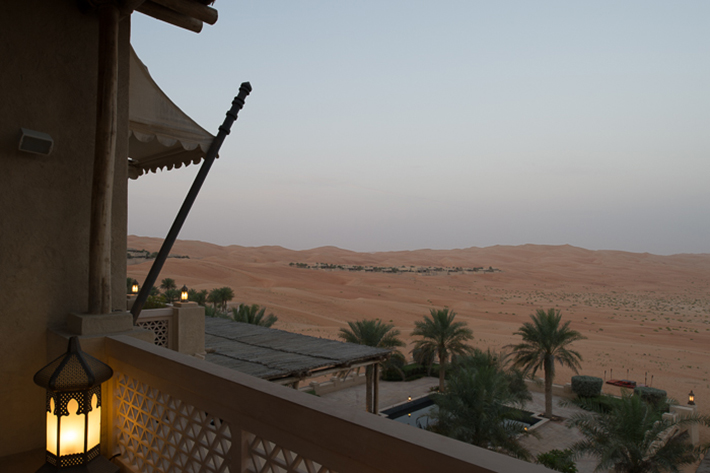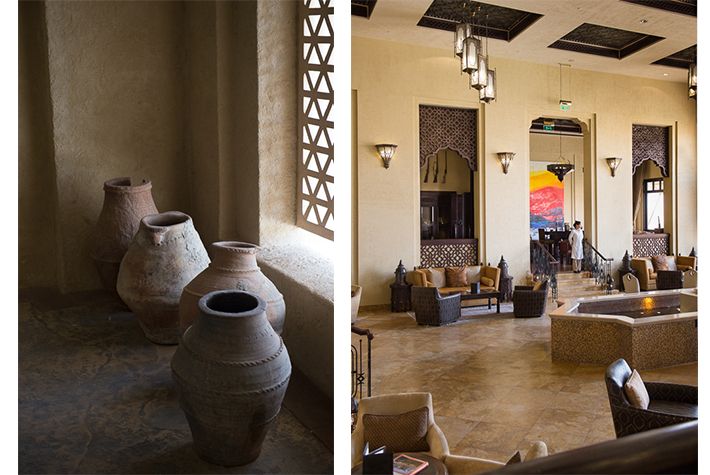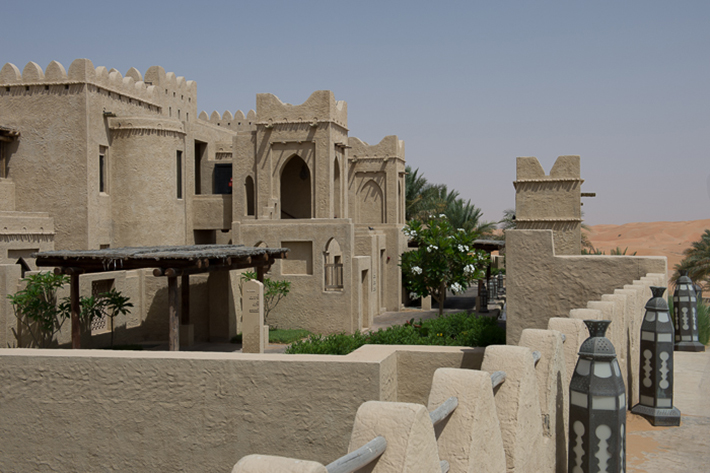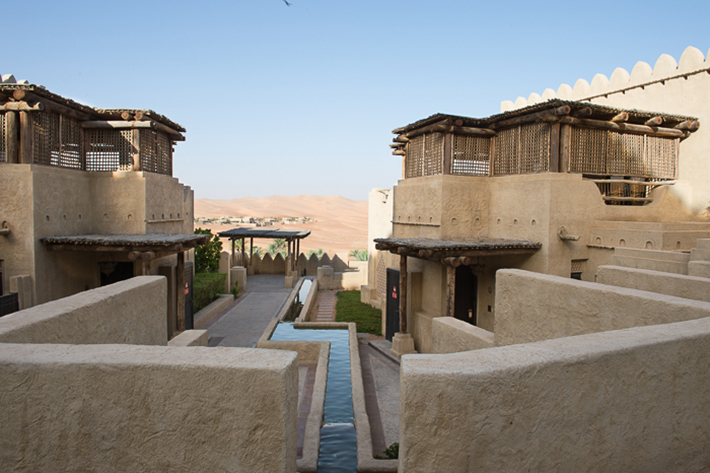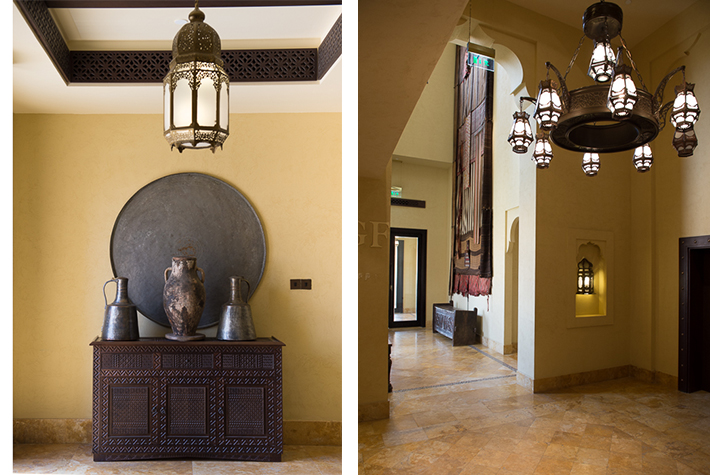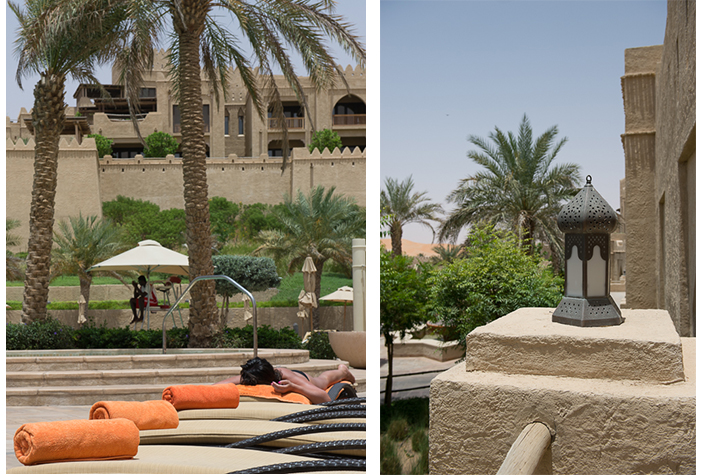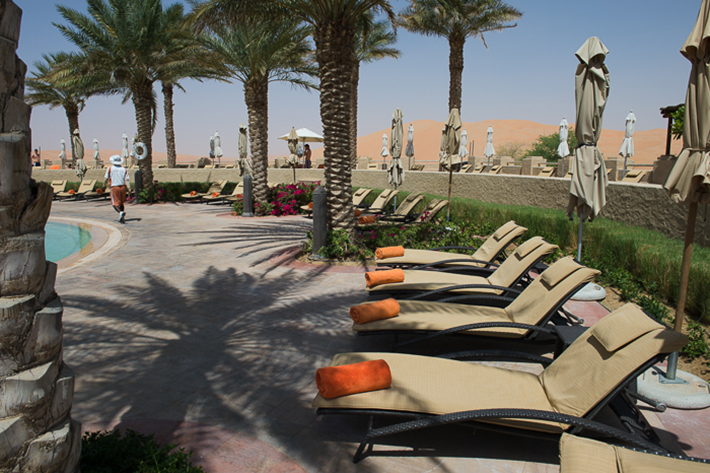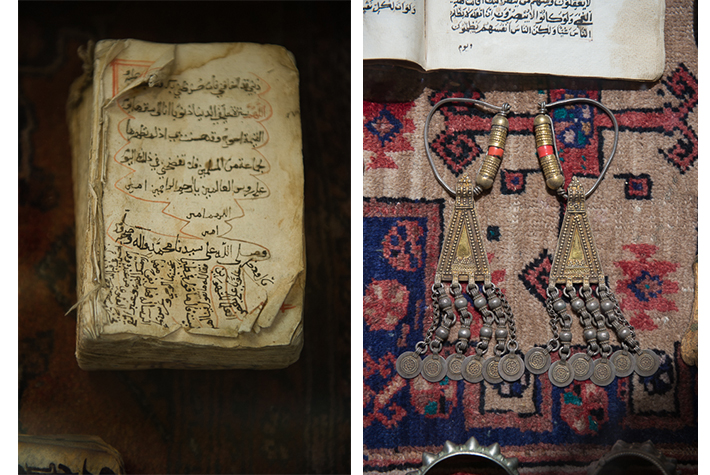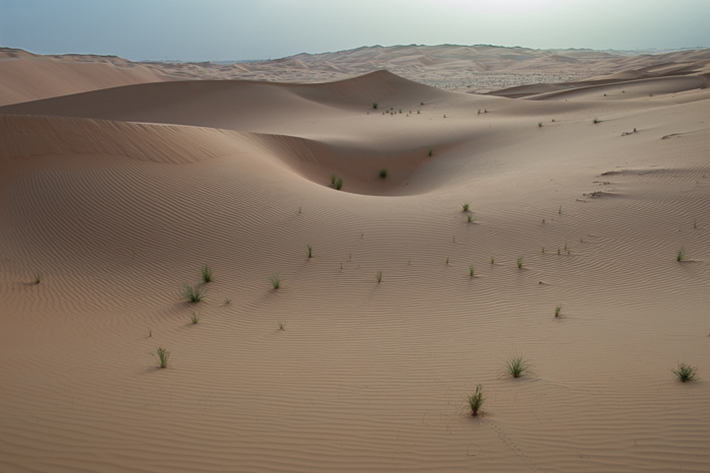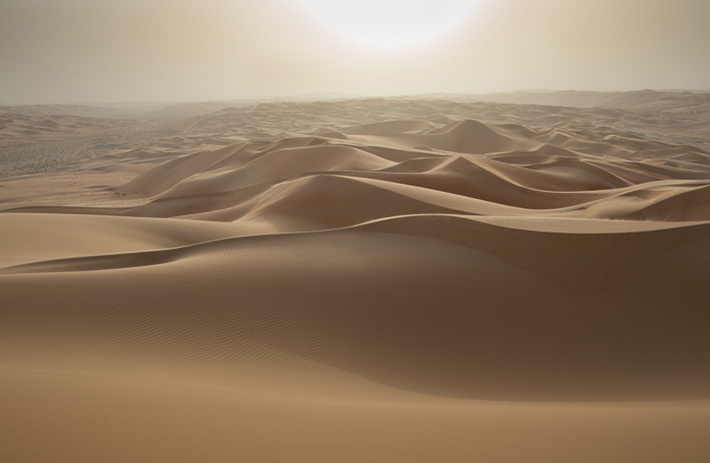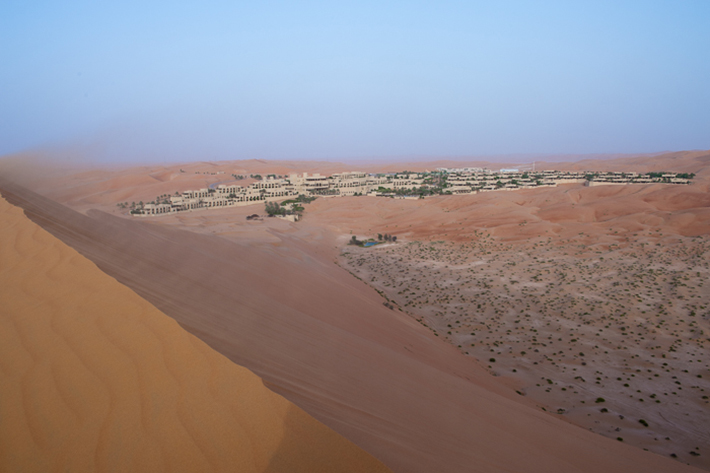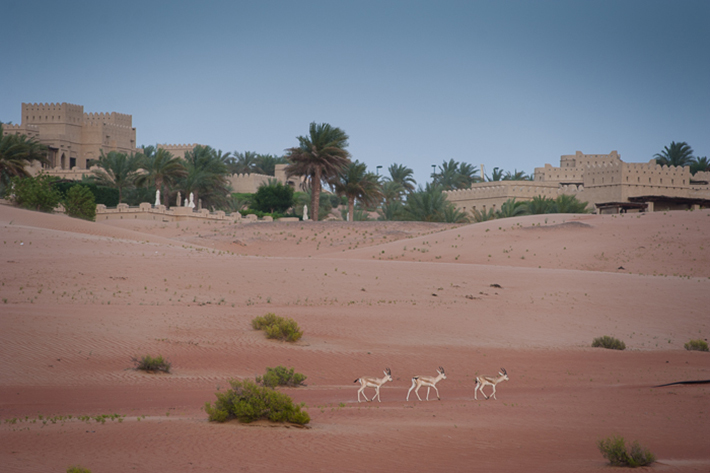Desert Awakening
A walk in Arabia's Empty Quarter
As I hike up
the shifting face of a massive dune in the Liwa desert, I have to come to terms with the real meaning of sand. Without a headscarf or an abaya I’m seriously underdressed for the excursion, as a morning wind whips up the fine sand and gives my face an unwelcome microdermabrasion. A day later I’ll still be scraping grains of sand from my ears, my hair follicles, the corners of my eyes and from my gums.
The morning began still and clear but the desert is like an immense sleeping creature that stirs and shifts beneath my feet. With guide André, I’ve set out in the dark to begin the walk before the sun comes up. The best place to begin, a wadi where the waters run on one of the few days when it rains, is about a fifteen minute drive from Anantara’s Qasr al Sarab resort where I’m staying, which is in turn a ninety minute drive from Abu Dhabi.
There’s nothing like a bit of dune bashing to get your brain rattling, especially when it’s dark and you have no idea where you’re going. But there’s a sliver of pale light as we reach the wadi and I can see we’re surrounded by dunes of the softest apricot colour, sculpted by darker red iron deposits and sprinklings of white salt. If I ever thought sand was merely sand-coloured, I can see my error now.
This is the edge of the Rub’ al Khali or Empty Quarter, the 650,000 sq km of sand that begins in the United Arab Emirates and takes in parts of Saudi Arabia, Yemen and Oman. But it’s not necessarily ‘empty’ – even in this light we can see the footprints of desert creatures and the trails made by the bellies of snakes. The sight means I’m not too happy about tackling the dunes with bare feet but the sand is so silky I soon forget the fear of ambush by giant spiders.
André points ahead to a dune that’s about eight metres high… and then a series of them unfolding to the horizon. I’m not at all convinced that I have the stamina to reach the furtherest peak, especially now as the wind is blowing hard in our faces, but when I express misgivings André tells me an elderly couple did it just the day before, which of course makes me resolved to succeed.
After about forty minutes of giving the thighs a great workout climbing up hills, down into troughs and then hiking up higher dunes, we reach the knifepoint edge of a crest, just as the quivering globe of the sun arrives on the horizon, warming the sand to a terracotta colour. Savouring the piquant silence, I feel the wonderful lightness of being. We could be on another planet, the construction cranes of Abu Dhabi light years away.
One of the resort’s guides does the dune walk most mornings, as part of the program of activities offered to guests. Qasr al Sarab sprung up in the desert about five years ago, providing one of the best excuses we can think of for a stopover in go-ahead Abu Dhabi. With the gardens grown a little lusher and some age on the new buildings, the resort will soon look like it’s been there for centuries.
Stretching 2.7 km in length, including private villas, pool, tennis courts and a separate spa pavilion, Qasr al Sarab is constructed like a traditional desert fortress village around courtyards and fountains and decorated with 2500 pieces of rare artefacts, such as weathered camel hide trunks, Bedouin silver and leather-bound books gathered from old ports and markets.
Savouring the piquant silence, I feel the wonderful lightness of being.
Arriving from Abu Dhabi (or Dubai) where there is little history left, it’s a relief to find an oasis where the beauty of the traditional architecture is respected. With all mod-cons such as air conditioning, wifi, plasma TVs, pool with swim-up bar and helipad, the simple mudbrick village concept has had quite an update, but local artisans have been used wherever possible to recreate authentic structures and spaces. The gracious lobby lounge with its reflecting pool is filled with local men in Emirati dress, eating dates and sipping pomegranate juice, and veiled women visit the spa in groups or dine on Emirati delicacies by the pool, so it’s evident the local community has responded well to the aesthetic revival of 9000 years of tradition.
Qasr al Sarab has been honoured as the UAE’s best desert resort an impressive number of times and in 2016 and 2017 as the World’s Best Desert Spa in the World Spa Awards. What is magical about it is that dunes entirely surround the resort, to the point where you’re likely to get the faintest dusting of sand on your skin while you’re lounging about by the pool on one of the tented daybeds.
My suite is situated at the top of the village, with access to its own terrace and garden and, looking across fortress walls to the changing colours of a huge dune, it’s the perfect spot to catch the magnificent sunsets each night. I’m reliably informed that there are 24 different changes in the colour of the sand – and there are about that many in the colour of the sky.
Qasr al Sarab has many different eating experiences, from a luscious buffet breakfast to international and Emirati fine dining (the camel milk crème brulee is a must) but none so romantic as the opportunity to dine à deux in the dunes by lamplight or under Bedouin tents alone or with as many as twenty friends. The ‘dining by design’ concept means you can dine wherever you like providing it’s possible (in other words, not in a sandstorm.) And there’s room service, of course. The ten royal villas, housed in a separate ‘village,’ have their own butlers.
The best way to rid yourself of sand is to visit the Anantara spa for a scrub in the private hammam. The spa is like a palatial residence, set around a garden courtyard with splashing fountain. The treatment rooms open right on to the sand dunes. The menu includes a collection of Thai-based treatments and a 5, 7 or 10-night wellness program incorporating massage, diet, exercise (under their abayas, the Emirati women are as concerned about weight loss as westerners.) After being steamed, scrubbed, sluiced with warm water, massaged from scalp to toes, soaked in a fragrant spa bath and slathered with jasmine-scented body cream, there’s not a grain of sand left on me – until I take the outdoor path back to my room in a minor sandstorm. No problem – I’ll just have to do it again tomorrow!
The resort comprises a desert experience centre designed to educate visitors on the surrounding environment and to offer activities relevant to the region including falconry, camel riding and desert exploration. There is also a children’s playground and kid’s club. The high season is September-April, with the Al Dhafra Camel Festival in December.
Qasr al Sarab Resort by Anantara features 206 rooms and villas, each with desert views. The new Royal Pavilion Villas are 10 fully self-contained villas with swimming pool, lawn, outdoor rainforest shower, sunbathing cabana, terrace, lounge, dining room, workout room and spa.
Bookings: visit anantara.com

